Intel 12th-Gen Alder Lake Pricing, Benchmarks, Specs and All We Know
Into the hybrid x86 era
- Intel's 12th-Gen Alder Lake At a Glance
- Intel Alder Lake Release Date
- Intel Alder Lake-S Desktop PC Specifications and Pricing
- Intel Alder Lake Gaming Benchmarks and Performance
- Intel Alder Lake Application Benchmarks
- Intel Alder Lake Power Consumption, Efficiency, and Thermals
- Intel Laminar Stock Coolers
- Intel Alder Lake-P and Alder Lake-M Mobile Processor Specifications
- Intel Alder Lake 600-Series Motherboards, LGA1700 Socket, DDR5 and PCIe 5.0
- Intel Alder Lake: TDP vs PBP and MTP
- Intel 12th-Gen Alder Lake Xe LP Integrated Graphics
- Intel Alder Lake CPU Architecture
- Intel Thread Director
Alder Lake has finally arrived to the market and we now have our reviews of the leading-edge Core i9-12900K, Core i7-12700K, and Core i5-12600K, and Core i5-12400 with all of the performance benchmarks and analysis. Overall, the Core i5-12600K is now the Best CPU for gaming on the market, while the Core i7-12700K slots in as the best high-end processor for mainstream platforms. Intel has also released a full lineup of 22 additional lower-priced desktop Alder Lake chips and a new lineup of Laminar coolers. We've also included our full performance benchmarks in the article below.
Intel's 12th-Gen Alder Lake chips bring the company's hybrid architecture, which combines a mix of larger high-performance cores paired with smaller high-efficiency cores, to desktop x86 PCs for the first time. Intel has already released the higher-end models for the desktop PC, but the company has augmented those chips with the more mainstream models it recently launched. It also appears that Intel will also add the new design to its lowest-end chips, too. We also expect the Alder Lake models for laptops to also arrive in January.
| Row 0 - Cell 0 | Price | Cores | Threads | P-Core Base/Boost | E-Core Base/Boost | TDP / PBP / MTP | DDR4-3200 | L3 Cache |
| Core i9-12900K / KF | $589 (K) - $564 (KF) | 8P + 8E | 16 Cores / 24 Threads | 3.2 / 5.2 GHz | 2.4 / 3.9 GHz | 125W / 241W | DDR4-3200 / DDR5-4800 | 30MB |
| Core i7-12700K / KF | $409 (K) - $384 (KF) | 8P + 4E | 12 Cores / 20 Threads | 3.6 / 5.0 GHz | 2.7 / 3.8 GHz | 125W / 190W | DDR4-3200 / DDR5-4800 | 25MB |
| Core i5-12600K / KF | $289 (K) - $264 (KF) | 6P + 4E | 10 Cores / 16 Threads | 3.7 / 4.9 GHz | 2.8 / 3.6 GHz | 125W / 150W | DDR4-3200 / DDR5-4800 | 16MB |
| Core i5-12400 / F | Estimated ~ $185 - $160 | 6P + 0E | 6 Cores / 12 Threads | 4.4 / ~2.5 GHz | n/a | 65W / 117W | DDR4-3200 / DDR5-4800 | 18MB |
Intel's initial Alder Lake lineup starts with three chips and their graphics-less variants, with the flagship $589 Core i9-12900K, which Intel bills as the 'world's fastest gaming processor,' leading the charge with 16 cores and 24 threads. Intel claims this chip provides an average 13% generational jump in gaming performance, beats AMD's Ryzen 9 5950X flagship by up to 30% in gaming, and offers up to twice the performance of its predecessor in content creation workloads. Intel even claims up to an 84% generational gain in fps in some game streaming scenarios.
We have our own testing in the article below, and there's no doubt that the Alder Lake chips are now the fastest gaming chips on the planet. They also bring amazing overclocking headroom for enthusiasts, offering up much more extra performance than AMD's Ryzen 5000 chips. You can see the breakdown of that advantage in our How to Overclock a CPU guide. You can also see how Alder Lake fares against AMD's comparable chips in these dedicated head-to-head articles:
- Ryzen 7 5800X3D vs Core i7-12700K and Core i9-12900K Face-Off: The Rise of 3D V-Cache
- Intel Core i9-12900K vs Ryzen 9 5900X and 5950X: Alder Lake and Ryzen 5000 Face Off
- Intel Core i5-12600K vs AMD Ryzen 5 5600X and 5800X Face Off: Ryzen Has Fallen
- Intel Core i7-12700K vs AMD Ryzen 9 5900X and 5800X Face Off: Intel Rising
Alder Lake represents a massive strategic shift as Intel regains the uncontested performance lead against AMD's Ryzen 5000 series processors. AMD's Zen 3 architecture had taken the lead in our Best CPUs for gaming and CPU Benchmarks hierarchy, partly on the strength of Ryzen's higher core counts. That's not to mention the pressure from Apple's M1 processors that feature a similar hybrid design to Alder Lake and come with explosive single-threaded performance improvements of their own.
Intel's Alder Lake brings disruptive new architectures and supports features like PCIe 5.0 and DDR5 that leapfrog AMD and Apple in connectivity technology and also outstrip Ryzen's core counts in mobile designs.
It all starts with a new way of thinking for x86 chips by pairing high-performance and high-efficiency cores within a single chip. That well-traveled design philosophy powers billions of Arm chips, often referred to as Big.Little (Intel calls its implementation Big-Bigger), but it's a first for x86 desktop PCs. The Golden Cove architecture powers Alder Lake's 'big' high-performance cores, while the 'little' Atom efficiency cores come with the Gracemont architecture. Intel etches the cores on its 'Intel 7' process, marking the company's first truly new node for the desktop since 14nm debuted six long years ago.
Intel is going all-in: the company will reunify its desktop and mobile lines with Alder Lake. Intel says it will tune Alder Lake for high-performance, a must for desktop PCs and high-end notebooks. As evidenced by its opening salvo of 12th-Gen Alder Lake mobile lineup that tops out at 14 Cores and 5.0 GHz, it appears the company has done just that for mobile, too.
Get Tom's Hardware's best news and in-depth reviews, straight to your inbox.

Potent adversaries challenge Intel on both sides. Apple's Arm-powered M1 processors have set a high bar for hybrid designs, outperforming all other processors in their class with the promise of more powerful designs to come. Meanwhile, AMD's Ryzen 5000 chips have taken the lead over Intel's aging Skylake derivatives. Intel's Rocket Lake chips overtook AMD in single-threaded performance, but they still trail in multi-core workloads due to Rocket Lake's maximum of eight cores, while AMD has 16-core models for the mainstream desktop.
Intel certainly needed a come-from-behind design to thoroughly unseat its competitors, swinging the tables back in its favor like the Conroe chips did back in 2006 when the Core architecture debuted with a ~40% performance advantage that cemented Intel's dominance for a decade. Intel's Raja Koduri has already likened the transition to Alder Lake with the debut of Core, suggesting that Alder Lake could indeed be a Conroe-esque moment.
Intel's 12th-Gen Alder Lake At a Glance
- Alder Lake is available now
- Six flagship models: $589 Core i9-12900K, $409 i7-12700K, $289 i5-12600K. All three are also available as graphics-less KF models. Intel also has a range of 22 lower-priced models for desktop PCs.
- LGA1700 socket requires new motherboards
- The Alder Lake SoC will span from desktop PCs to ultramobile devices with TDP ratings from 9W to 125W, all built on the Intel 7 process. The desktop PC comes with up to eight Performance (P) cores and eight Efficient (E) cores for a total of 16 cores and 24 threads and up to 30 MB of L3 cache for a single chip.
- Alder Lake supports either DDR4 or DDR5 (LP4x/LP5, too). Desktop PC supports x16 PCIe Gen 5 and x4 PCIe Gen 4, while mobile supports x12 PCIe Gen 4 and x16 PCIe Gen 3, Thunderbolt 4, and Wi-Fi 6E.
- Intel's new hyper-threaded Performance (P) core, which comes with the Golden Cove microarchitecture designed for low-latency single-threaded performance, comes with an average of 19% more IPC than the Cypress Cove architecture in Rocket Lake. It also supports AVX-512 and AMX (a new AI-focused matrix-multiply ISA) for data center variants (both are disabled on consumer chips).
- Intel's new single-threaded Efficiency (E) core comes with the Gracemont microarchitecture to improve multi-threaded performance and provide exceptional area efficiency (small footprint) and performance-per-watt. Four small cores fit in the same area as a Skylake core and deliver 80% more performance in threaded work (at the same power). A single E core also delivers 40% more performance than a single-threaded Skylake core (at the same power) in single-threaded work (caveats apply to both).
- Intel's Thread Director is a hardware-based technology that assures threads are assigned to either the P or E cores in an optimized manner. This is the sleeper tech that enables the hybrid architecture.
- Four variants: -S for desktop PCs, -P for mobile, -M for low-power devices, -L Atom replacement, -N educational (probably Chromebooks)
Intel Alder Lake Release Date
The Alder Lake processors for the desktop PC and mobile markets are now available.
Intel Alder Lake-S Desktop PC Specifications and Pricing
| Row 0 - Cell 0 | U.S. Price | Cores | Threads | P-Core Base/Boost | E-Core Base/Boost | TDP / PBP / MTP | DDR4-3200 | L3 Cache |
| Ryzen 9 5950X | $799 | 16P | 32 threads | 3.4 / 4.9 GHz | - | 105W | DDR4-3200 | 64MB (2x32) |
| Core i9-12900K / KF | $589 (K) - $564 (KF) | 8P + 8E | 16 Cores / 24 threads | 3.2 / 5.2 GHz | 2.4 / 3.9 GHz | 125W / 241W | DDR4-3200 / DDR5-4800 | 30MB |
| Ryzen 9 5900X | $549 | 12P | 24 threads | 3.7 / 4.8 GHz | - | 105W | DDR4-3200 | 32MB (1x32) |
| Core i9-11900K | $549 | 8P | 16 threads | 3.5 / 5.3 GHz | - | 125W | DDR4-3200 | 16MB |
| Core i7-12700K / KF | $409 (K) - $384 (KF) | 8P + 4E | 12 Cores / 20 threads | 3.6 / 4.9 GHz | 2.7 / 3.8 GHz | 125W / 190W | DDR4-3200 / DDR5-4800 | 25MB |
| Core i7-11700K | $409 | 8P | 16 threads | 3.6 / 5.0 GHz | - | 125W | DDR4-3200 | 16MB |
| Ryzen 7 5800X | $449 | 8P | 16 threads | 3.8 / 4.7 GHz | - | 105W | DDR4-3200 | 32MB |
| Core i5-12600K / KF | $289 (K) - $264 (KF) | 6P + 4E | 20 Cores / 16 threads | 3.7 / 4.9 GHz | 2.8 / 3.6 GHz | 125W / 150W | DDR4-3200 / DDR5-4800 | 16MB |
| Core i5-11600K | $272 | 6P | 12 threads | 3.9 / 4.9 GHz | - | 95W | DDR4-3200 | 12MB |
| Ryzen 5 5600X | $299 | 6P | 12 threads | 3.7 / 4.6 GHz | - | 65W | DDR4-3200 | 32MB |
The Alder Lake chips use the Intel 7 process, which used to be referred to as '10nm Enhanced SuperFin' before Intel recently renamed its process nodes during its latest process and packaging roadmap update. The Golden Cove cores support Hyper-Threading, allowing two threads to run on a single core, while the smaller Gracemont cores are single-threaded. That means some models could come with seemingly-odd distributions of cores and threads. All Alder Lake chips support DDR4-3200 or DDR5-4800.
Intel's $589 16-core Core i9-12900K comes with eight P-cores that support hyper-threading, and eight single-threaded E-cores for a total of 24 threads. That's a 33% increase in thread count over the previous-gen Core i9-11900K. The P-cores have a 3.2 GHz base, and peak frequencies reach 5.2 GHz with Turbo Boost Max 3.0 (this feature is only on P-cores). This chip comes with 125W PBP (base) and 241W MTP (peak) power ratings.
The 12900K has a 100 MHz reduction in peak clock frequency compared to the 11900K, but that isn't too meaningful given the entirely new hybrid architecture — these chips will realize performance gains from using different core types for different tasks. Speaking of which, the E-cores have a 2.4 GHz base and stretch up to 3.9 GHz via the standard Turbo Boost 2.0 algorithms. The chip comes armed with 30MB of L3 cache and 14MB of L2.


At $589, the Core i9-12900K comes at a $40 premium over its prior-gen counterpart, squeezing in between the $799 16-core Ryzen 9 5950X and $549 Ryzen 9 5900X. That could be attractive if Intel's performance claims pan out (more later), but it leaves a sizeable $185 gap between the Core i9 and i7 families that Intel inadequately plugs with the graphics-less $564 Core i9-12900KF. It's logical to expect a filler product between Core i7 and i9 in the future (possibly like the Core i9-10850K).
The $409 Core i7-12700K comes with the same $409 tray pricing as the previous-gen Core i7-11700K and has eight P-cores and four E-cores, for a total of 20 threads. The P-cores run at a 3.6 / 5.0 GHz base/boost, while the E-cores weigh in at 2.7 / 3.8 GHz, all fed by 25MB of L3 cache and 12MB of L2. The graphics-less $384 Core i7-12700KF comes with a $25 price reduction.

The 12700K's $409 price point means that Intel has kept the Core i7 flagship at its same price point, where it lands between the $449 Ryzen 7 5800X and $399 Ryzen 5 5600X. The 12700K/F's increased performance could make it a more attractive part than its lackluster previous-gen counterpart, the hard-to-recommend Core i7-11700K.
The Core i5-12600K's $289 price point remains the same as the prior-gen Core i5-11600K, meaning it lands right smack dab in gamer country, going toe-to-toe with the $299 six-core Ryzen 5 5600X and representing the lowest point of entry to the Alder Lake family (at least for now). This chip comes with six threaded P-cores that operate at 3.7 / 4.9 GHz and four E-cores that run at 2.8 / 3.6 GHz, for a total of 16 threads. That's paired with 20MB of L3 and 9.5MB of L2 cache.
AMD's competing Ryzen 5 5600X currently leads our Best CPU for gaming list, but it faces a stiff challenge from Intel's 12600K.
All the Alder Lake chips support both DDR4 and DDR5 memory, but there are several caveats to the listed DDR5 support. As a default, DDR5 runs in Gear 2 mode, resulting in higher latency, and standard motherboards only support DDR5-4800 if the motherboard has only two physical slots. Therefore, at stock settings, the chip will only support DDR5-4400 on any motherboard with four slots, even if only two slots are populated.
Intel has discarded its 'TDP' (Thermal Design Point) nomenclature, and now assigns a Processor Base Power (PBP) metric in its place. The company also added a secondary Maximum Turbo Power (MTP) metric to its spec sheets to quantify the highest power level during boost activity (typically called PL2).
Alder Lake's new memory controllers support four different memory types: DDR5-4800 and LP5-5200, along with DDR4-3200 and LP4x-4266. This single design's broad memory support enables different types of memory configurations for different use-cases. It appears that Intel will split its memory support into DDR4 for lower-end Z690 motherboards, B- and H-series models, and mobile systems, while DDR5 will only slot in for the highest-end Z-series motherboards. This makes sense given the expected high pricing for DDR5 memory in the early days of adoption, though it's notable that Intel hasn't confirmed its approach yet.
Alder Lake also supports up to PCIe 5.0 with 64 GB/s of throughput across a x16 lane connection. The desktop PC chips support a x16 PCIe Gen 5 connection with an additional x4 PCIe Gen 4 connection (it is unclear if this x4 connection is used for the chipset or exposed to the user), while lower-power models support a x12 PCIe Gen 4 config paired with a x16 PCIe Gen 3 connection.
The first chips based on the design come in three different packages, each for a different segment: The desktop PC chip that will drop into new motherboards with an LGA 1700 CPU socket (yes, 115x coolers with converters are compatible), a high-performance BGA Type3 package for mobile applications (this is likely a 12-28W UP3 package, though Intel hasn't confirmed), and a high-density BGA Type4 HDI package for Ultra Mobile applications (likely a 7-15W UP4 equivalent for ultra-thins).
We have also learned that the Intel Alder Lake chips for desktop PCs will come with two die variants, with one being a six-core with p-cores only, while the other will come with the standard (up to) eight p-cores and eight e-cores.
Intel Alder Lake Gaming Benchmarks and Performance

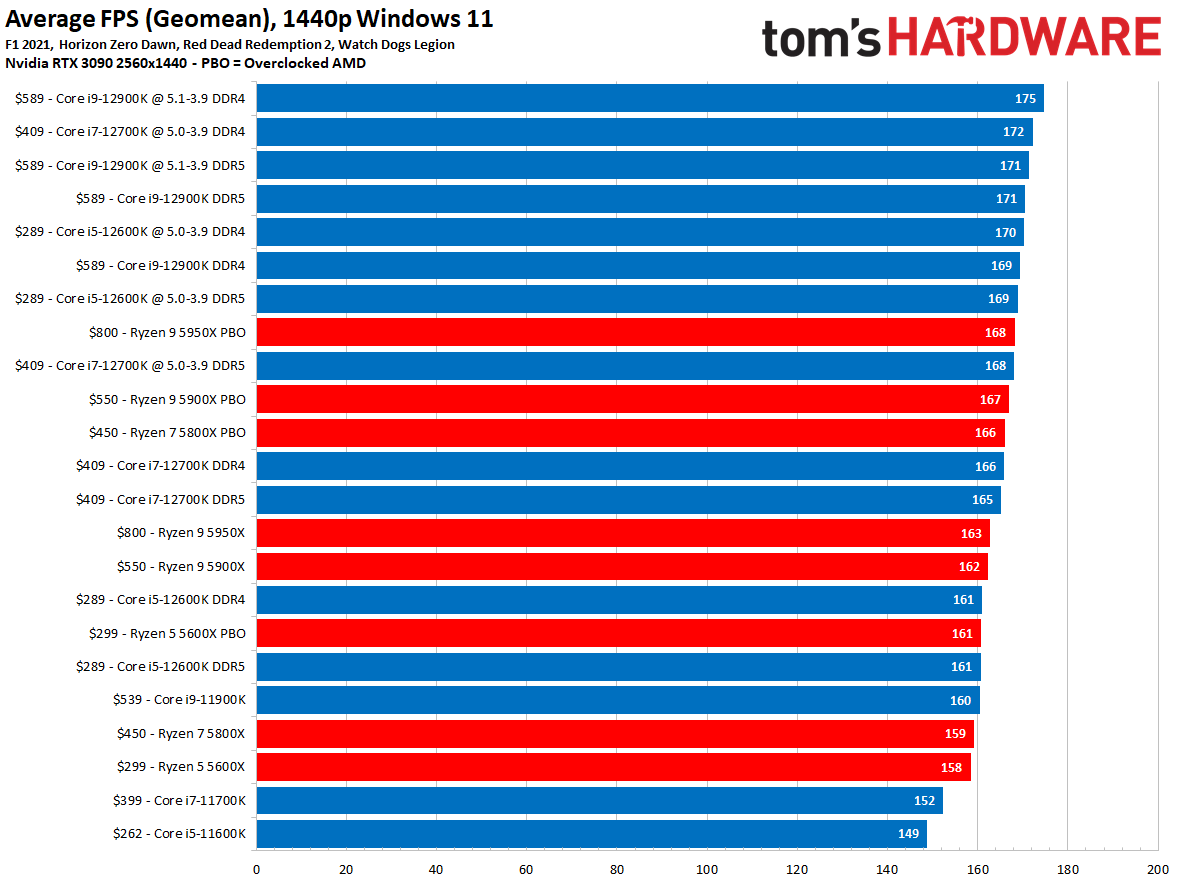






Here's the overall testing from our review, which has additional analysis. Above you can see gaming results in both Windows 11 and Windows 10. The $549 12-core Ryzen 9 5900X is AMD's fastest gaming chip, but the $589 Core i9-12900K is 8.7% faster in the cumulative 1080p gaming measurement across our entire test suite. And that's with both the DDR4 and DDR5 memory configurations, so you won't have to drop serious cash on a DDR5 kit to get there.
Stepping down $300, the $289 Core i5-12600K with DDR5 memory is ~2.7% faster than the $299 Ryzen 5 5600X, but that gap widens slightly with less expensive DDR4 memory. The Core i5-12600K also effectively ties the Ryzen 7 5800X, but for $161 less.
Rocket Lake buyers will be plenty disappointed. The Core i9-11900K landed a mere six months ago at $539, but the 12900K is ~11% faster in gaming. It's also much faster in the threaded workloads that we'll see later in our application testing. We see a similar story unfold with the Core i5-11600K compared to the 12600K, with 9% more performance in gaming coming for $27 more.
Naturally, moving over to 1440p brings a GPU bottleneck into the equation, so the performance deltas between the chips shrink tremendously. Here the Core i5-12600K effectively ties the 5600X and 5800X, while the 12900K is a mere 3.6% faster than the Ryzen 9 5950X.
The Core i9-12900K slots in as the fastest gaming chip on the planet, price be damned, but the Core i7-12700K delivers basically the same gaming performance for far less cash, making it the go-to choice for performance addicts. For mainstream gamers, the Core i5-12600K offers the best blend of price and performance that you can find on the market, bar none.
Flipping through the 99th percentile charts shows larger deltas, but we have to view those with caution as Windows 11 is still young and seems to suffer from more framerate variability than our Windows 10 test platform. This could result from yet-to-be-updated game code, the relatively new graphics drivers for Windows 11, or some other combination of factors that could be smoothed out in the future.
Intel's Alder Lake carves out a win in Windows 11, but large performance deltas in a few of the game titles can heavily impact these types of cumulative measurements. For instance, Intel enjoys a sizeable lead in Hitman 3, but that game is specifically tuned to leverage the E-cores effectively by offloading low-priority tasks like physics to the small cores. That can be seen as an advantage by some because more game devs could take this approach, or as a fluke by others that think this type of optimization will only come to Intel-sponsored titles.
Note: AMD has since released its Ryzen 7 5800X3D, which takes the overall lead in gaming performance, though it does trail in other metrics, like performance in single- and multi-threaded application workloads. This highly-specialized chip also doesn't accelerate all games, as it only benefits titles that prize L3 cache. You can read more about this in our Ryzen 7 5800X3D review.
The competition between Intel and AMD is absolutely closer now, so it's best to make an informed decision based on the types of titles you play frequently. Be sure to check out the individual tests below.





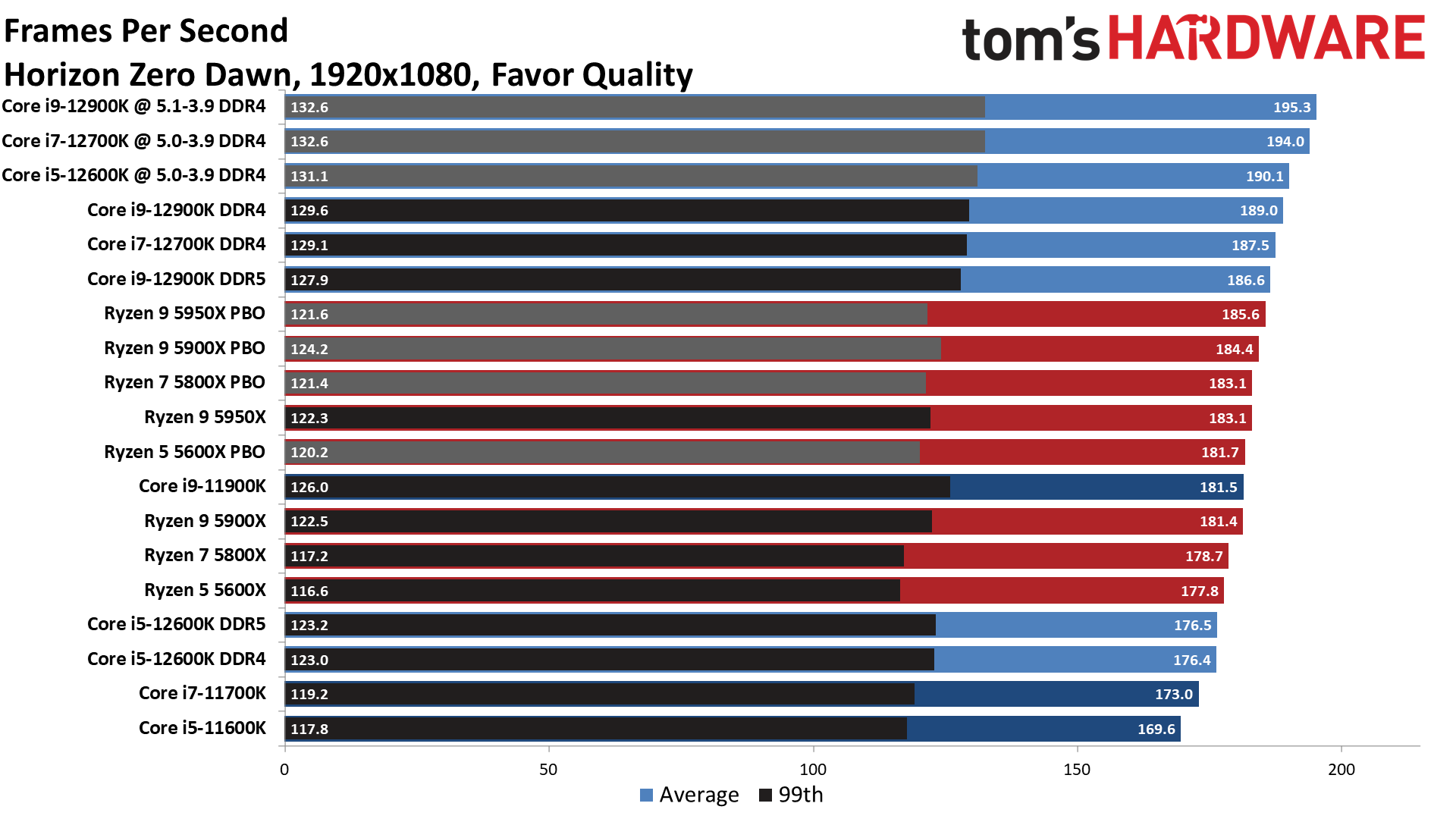

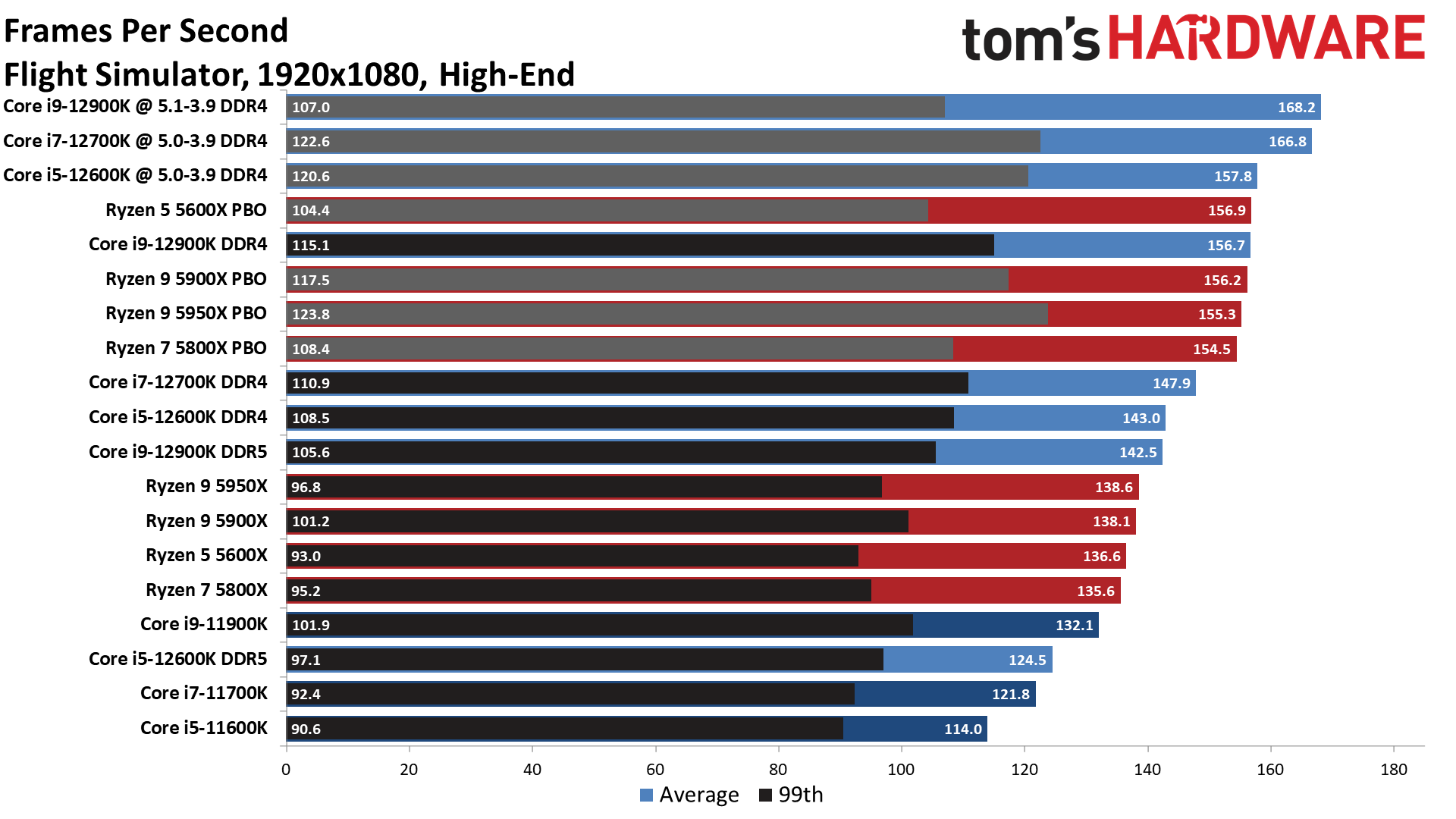



There were teething pains, though. As we reported, Denuvo DRM falsely identified Intel's E-cores as a separate system, and thus 91 Denuvo-enabled game titles wouldn't work with Alder Lake chips. Intel has worked with Denuvo, and the software maker issued a flurry of game patches to fix the issue. Now the list of broken games on Alder Lake is down to just three.
Additionally, Process Lasso has now added adjustments that will help address any performance issues in Windows 10.
Intel Alder Lake Application Benchmarks
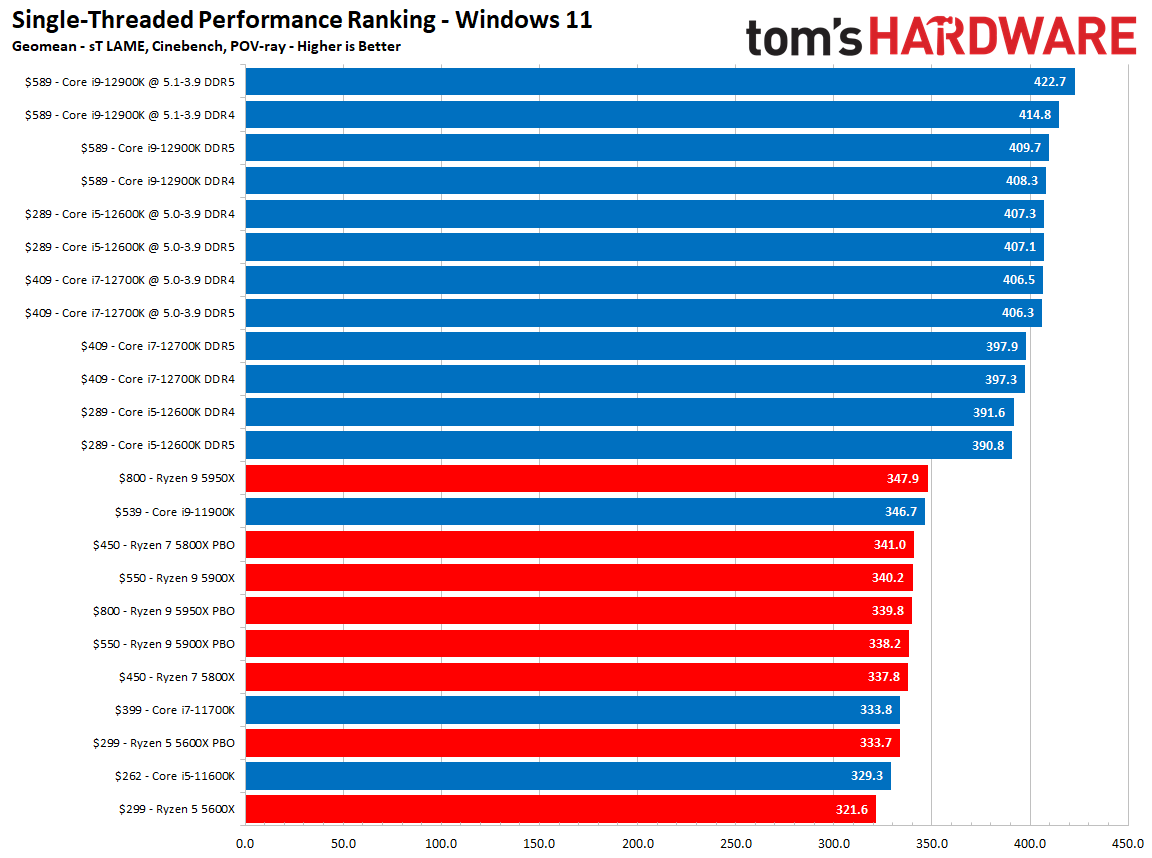



We can boil down productivity application performance into two broad categories: single- and multi-threaded. These slides show the geometric mean (equal weighting to all tests) of performance in several of our most important tests in each category, but be sure to look at the expanded results below.
Alder Lake delivers a few stunning wins in the threaded workloads that Ryzen has dominated for so long, highlighting the advantages of the x86 hybrid architecture. It is quite surprising to see the 24-thread Core i9-12900K with DDR5 memory tie the 32-thread Ryzen 9 5950X in the multi-threaded ranking, but even more surprising to see it take a 3% lead with DDR4. That's pretty impressive in light of the 5950X's $800 price tag.
The Core i5-12600K is equally impressive in its price range as it is 38% faster in threaded work than the comparably-priced 5600X, and 7% faster than the 5800X that costs $161 more.
The deltas in favor of Alder Lake are even more convincing in the single-threaded metric, but you shouldn't put undue importance on this metric because it is comprised of a few very specific workloads. You can see a broader spate of lightly-threaded workloads below. Needless to say, Alder Lake dominates those types of workloads. Check out our review for the blow-by-blow on all of the different benchmarks.
Intel Alder Lake Power Consumption, Efficiency, and Thermals





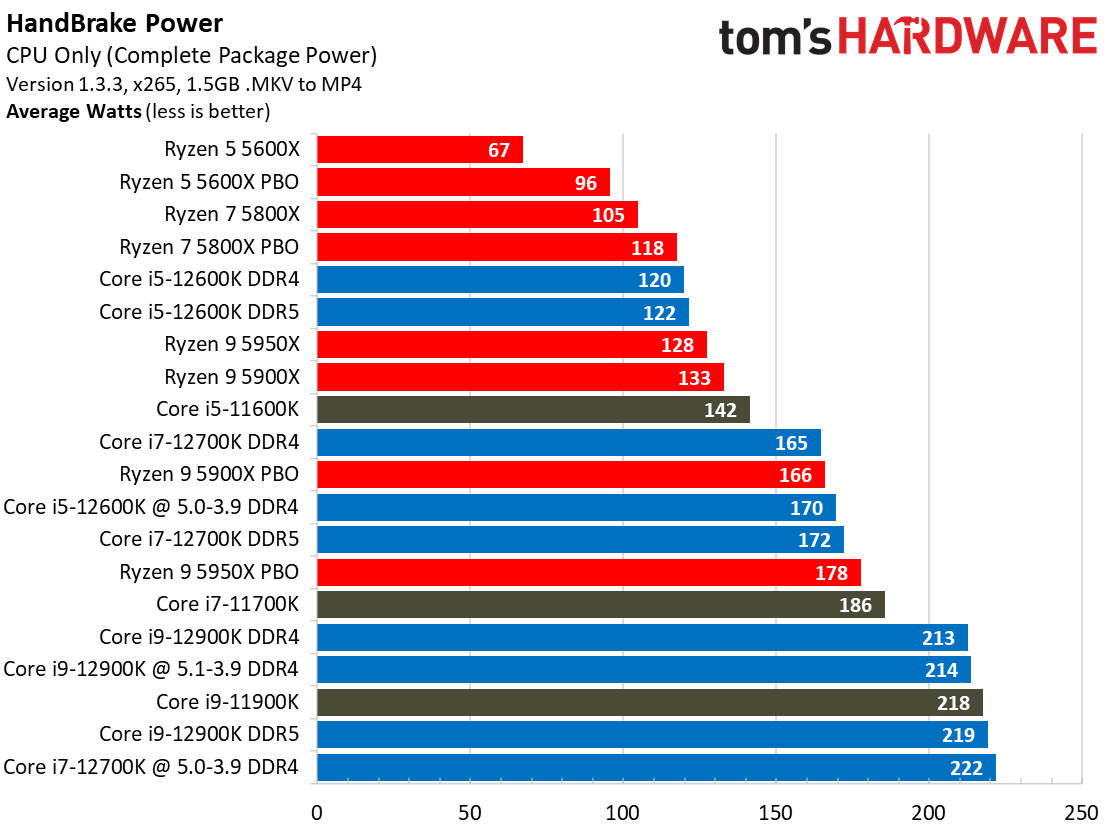





Yes, Alder Lake still sucks more power than AMD's Ryzen 5000 series chips, but the arrival of the Intel 7 process does mark a big improvement. As we can see, the Alder Lake chips consume far less power than the Rocket Lake chips — we measured a peak of 238W with the 12900K, while the previous-gen 11900K drew nearly 100W more during the same Blender workload.
Overall, Intel has reduced its power consumption from meme-worthy to an acceptable level. Besides, Alder Lake is much faster than its predecessor, earning it some leeway.
For instance, as you can see in our renders-per-day measurements, the Core i9-12900K and 12600K are both twice as efficient as their predecessors, which is commendable. This lower power consumption results in lower cooling requirements, too.




Here we take a slightly different look at power consumption by calculating the cumulative amount of energy required to perform Blender and x264 and x265 HandBrake workloads, respectively. We plot this 'task energy' value in Kilojoules on the left side of the chart.
These workloads are comprised of a fixed amount of work, so we can plot the task energy against the time required to finish the job (bottom axis), thus generating a really useful power chart.
Bear in mind that faster compute times, and lower task energy requirements, are ideal. That means processors that fall the closest to the bottom left corner of the chart are best.
As you can see, Intel's chips have descended from the undesirable upper right of the chart down to the lower left hand, nearly matching AMD's chips in power consumption while actually being faster. That's an outstanding improvement after six years of power-guzzling 14nm chips.
Intel Laminar Stock Coolers
We’ve already seen signs of Intel’s new Laminar coolers in the wild, but now we have the full details. These coolers are designed to address two major deficiencies with Intel’s stock coolers: Thermal dissipation limitations and aesthetics. AMD’s stock coolers have long beat Intel in both of these departments, so this is a sorely-needed upgrade.


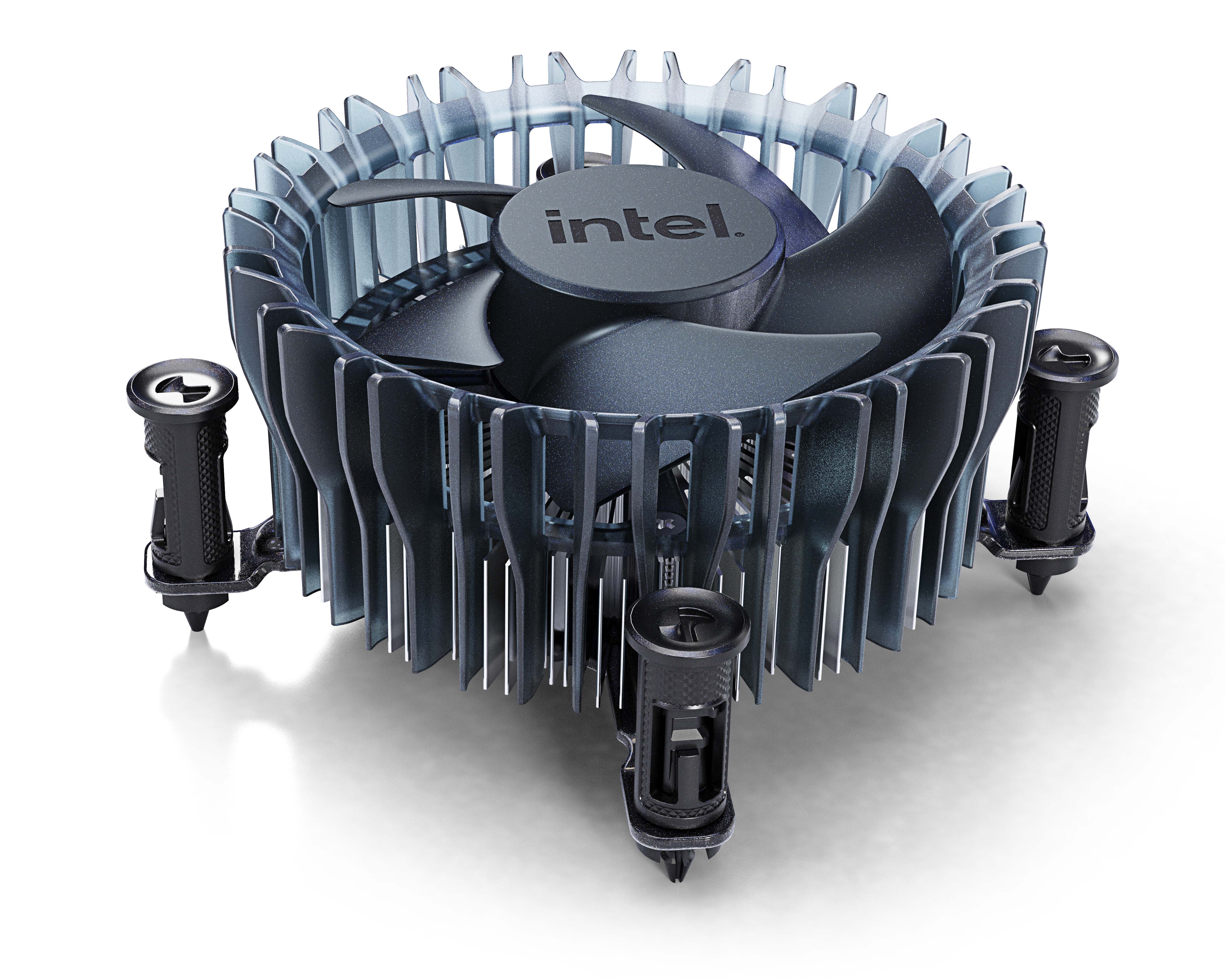
The Laminar coolers drop onto the LGA1700 socket and come in three variants. The Laminar RH1 has controllable aRGB lighting and features a large copper slug to improve thermal dissipation. Intel claims near-silent operation at 2.6 BA. This cooler ships with the locked Core i9 model.
The Laminar RM1 drops in for the Core i7, i5, and i3 non-K models and comes without RGB lighting (it does have a decorative blue ring lining the fin stack). Intel rates this cooler for ‘quiet performance’ at 3.9 BA. The Laminar RS1 rounds out the new family of coolers, but it’s the smallest of the bunch and will only ship with the lower-power Pentium and Celeron chips. This cooler doesn’t have a listed noise rating, so you should expect it to be fairly noisy.
Intel will also make these coolers available separate from the chips, but you have to buy them in lots of 1000. While that puts it out of reach for most of us to purchase directly from Intel, this means that we will eventually see these coolers filter out to retail outlets via third-party sellers. We’re working to source these coolers for in-depth testing; stay tuned.
Intel Alder Lake-P and Alder Lake-M Mobile Processor Specifications
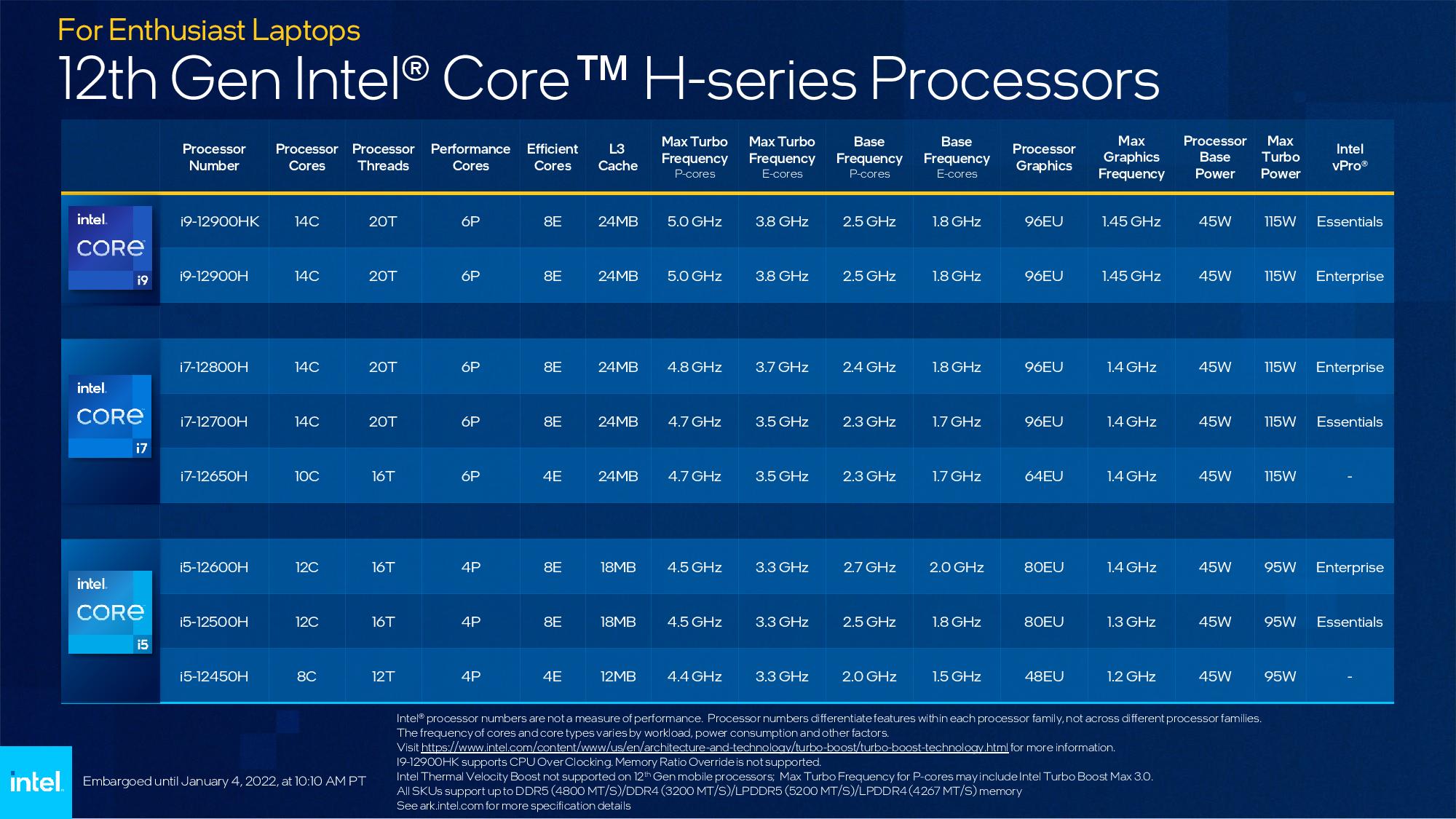
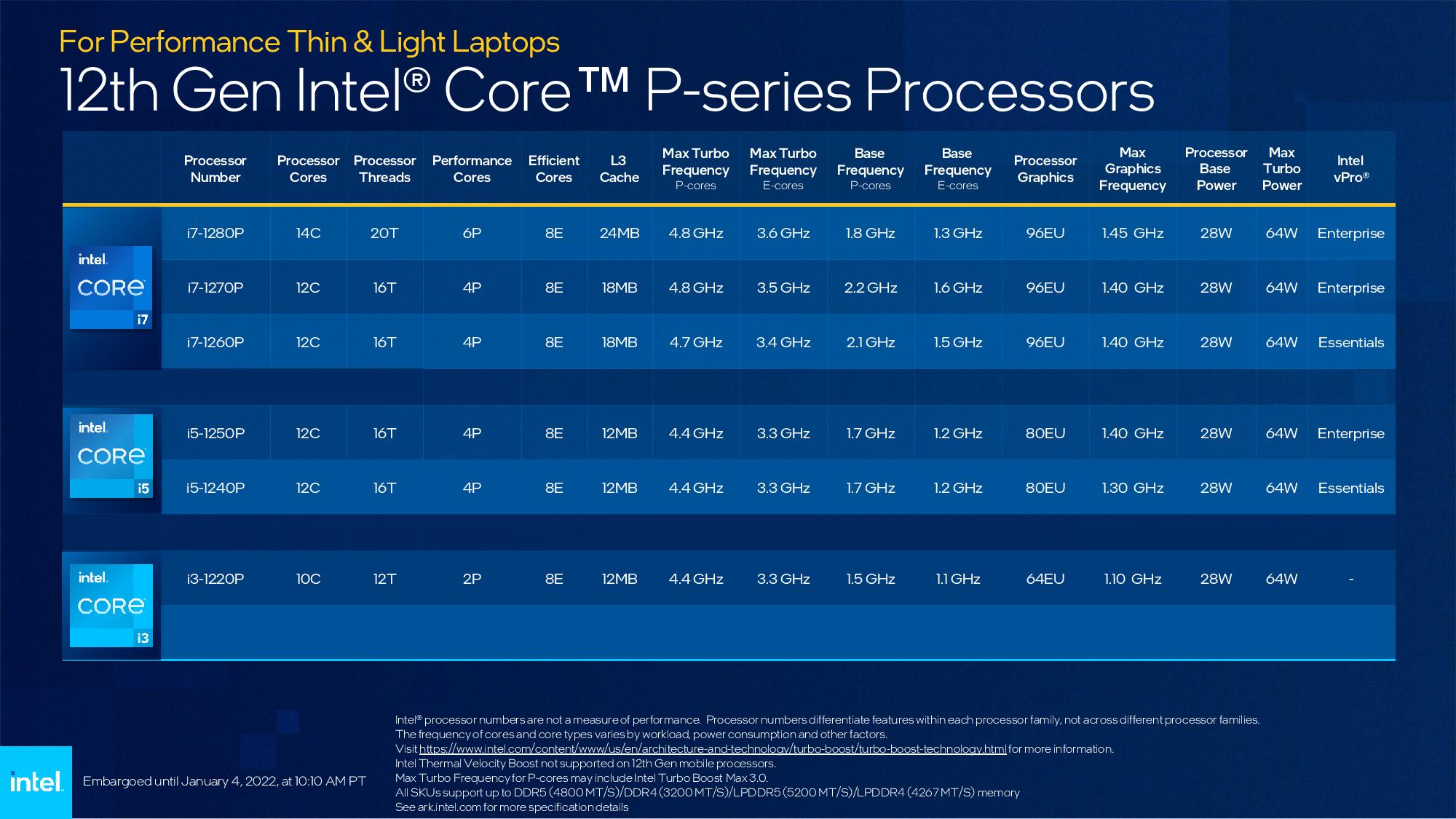


The Alder Lake mobile chips support DDR5-4800 and LPDDR5-5300, while Apple M1-based chips support LPDDR-6400 and AMD has LPDDR5-5500. You’ll only find the DDR5 interfaces on the higher-end Alder lake products, and support for standard DDR5 enables end-user configurability. Intel also has options for DDR4-3200 and LRPDDR4x-4267 interfaces, which you’ll find DDR4 options on the more value-oriented platforms. All told, the Alder Lake platform supports four different types of memory technologies, which Intel says is a first for a mobile platform.
Intel also supports the PCIe 5.0 interface for desktop chips but cited both a lack of end-user devices and a lack of time to qualify the faster interface for the mobile models. As such, all of the Alder Lake mobile chips only support PCIe 4.0.
Intel’s H-series lineup spans the Core i9, i7, and i5 families with a total of eight 45W SKUs designed for high-end laptops. These chips can consume up to 115W for short periods during intense work (duration varies based on the laptop’s cooling capabilities), which will invariably impact power consumption. Intel hasn’t provided battery life projections yet (it says it will in the future) but is frank that the Alder Lake series is tuned for performance. As such, we should expect higher gen-on-gen performance but similar battery life. Intel’s performance benchmarks below are impressive, but similar battery life won’t do much to address the elephant in the room: The Apple M1-based laptops.
As you’ll notice, the Alder Lake chips top out at six performance cores while Intel’s previous-gen mobile processors had up to ten cores. Intel augments the six P-cores with up to eight E-cores, which allows the processor to provide similar or better performance in multi-threaded workloads than the previous-gen ten core models. Naturally, the P-cores’ higher IPC also delivers more performance in single-threaded work.
The Core i9-12900HK is the halo chip with six P-cores and eight E-cores, with the former operating at up to 5.0 GHz while the latter boosts to 3.8 GHz. The P-cores feature hyperthreading, which means each host two threads, while the E-cores are single-threaded. As a result, the Core i9-12900HK has 14 cores and 20 threads. It also comes armed with the Intel Iris Xe graphics engine with 96 EUs. (some of the i7 and i5 models have fewer EUs).
Intel also unveiled the specifications for its P- and U-series chips but didn’t provide any additional commentary. However, we can see that the P-series chips have a 28W TDP and jump to a 64W TDP under load. These chips come with either four or six P-cores paired with eight E-cores. These chips are designed for performance thin-and-light laptops.
The U-series is designed for thin-and-lights and supports default 9 or 15W TDPs, but can jump to 29W or 55W, which is quite the dynamic range. The U-series models come with two P-cores and either four or eight E-cores. The U-series drops down to five-core six-thread Pentium and Celeron models, an odd arrangement that’s reminiscent of Lakefield, Intel’s first hybrid chip. These U- and P-series chips will come to market later in Q1, and Intel says it will share more details then.
Intel Alder Lake 600-Series Motherboards, LGA1700 Socket, DDR5 and PCIe 5.0


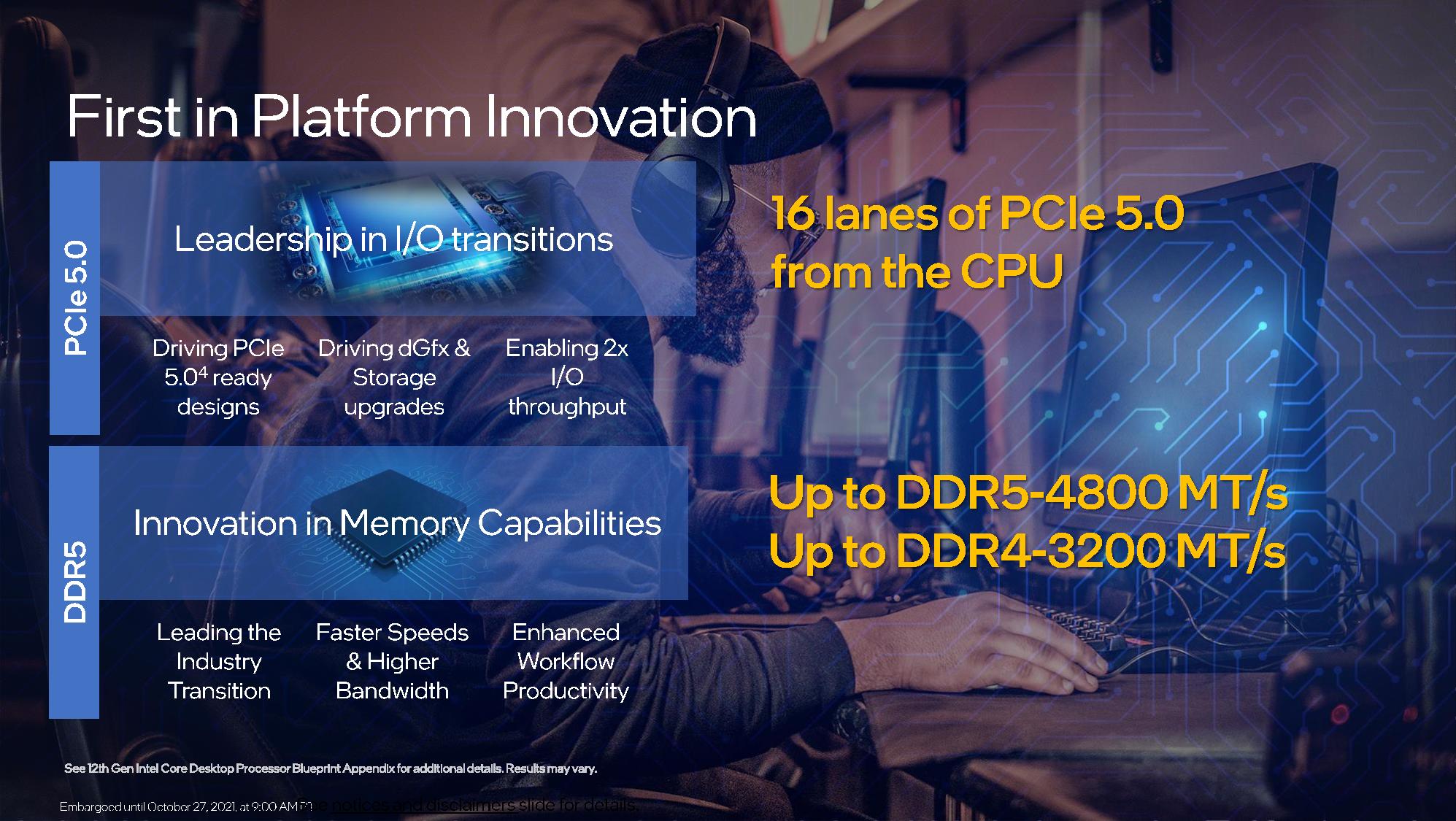
Intel's incessant motherboard upgrades, which require new sockets or restrict support within existing sockets, have earned the company plenty of criticism from the enthusiast community — especially given AMD's long line of AM4-compatible processors. That trend will continue with a new requirement for LGA1700 sockets and the 600-series chipset for Alder Lake (we've already seen plenty of listings and pictures of Z690 motherboards). Still, if rumors hold true, Intel will stick to the new socket for at least the next generation of processors (7nm Meteor Lake) and possibly for an additional generation beyond that, rivaling AMD's AM4 longevity.
Intel also introduced its 14nm Z690 chipset for the initial release, and you can read about the chipset and some of the first 60+ motherboards in our Z690 motherboard roundup here. There's a wide selection of DDR5 motherboards spread among the various motherboard makers' high- and lower-end Z690 families. However, DDR4 models appear to be confined to the lower-end Z690 boards (unlike previous generations, no motherboard supports both DDR4 and DDR5). We expect pricing for DDR5 to be substantially higher than DDR4, currently projected to be a 50 to 60% markup, for some time.
Z690 motherboards are more expensive than lower-end alternatives, but we expect the lower-end Alder Lake H670, B660 and H610 motherboards to be announced at CES 2022.
Alder Lake supports up to 16 lanes of PCIe 5.0 (technically for storage and graphics only, no networking devices) and an additional four lanes of PCIe 4.0 from the chip for M.2 storage. Intel has also added 12 lanes of PCIe 4.0 that hang off the chipset, a nice step up from the Z590 chipset's PCIe 3.0 support. That provides a total of 28 PCIe platform lanes for Alder Lake systems. Intel also doubled the throughput of the DMI connection between the chip and chipset from an x8 DMI 3.0 pipe, which clocks in at 7.88 GB/s, to an x8 DMI 4.0 connection that delivers 15.66 GB/s. Intel also added support for the Volume Management Device feature that enables PCIe SSD management and the ability to create bootable RAID configurations.
Because the LGA1700 socket is bigger than the current sockets used in LGA1151/LGA1200 motherboards, existing coolers may be incompatible, but cooler conversion kits, which most cooler makers will provide for free for existing customers, can accommodate the larger socket. (Coolers that support both LGA11xx and LGA2066 already exist, so an in-between option isn't too difficult.)
The larger socket is needed to accommodate 500 more pins than the LGA1200 socket. Those pins are needed to support newer interfaces, like PCIe 5.0 and DDR5, among other purposes, like power delivery. Intel has also listed Alder Lake-S BGA support documentation, indicating that soldered-down models will also come to market.
PCIe 5.0 and DDR5 support give Intel a connectivity advantage over competing chips, but there are a lot of considerations involved with these big technology transitions. As we saw with the move from PCIe 3.0 to 4.0, a step up to a faster PCIe interface requires thicker motherboards (more layers) to accommodate wider lane spacing, more robust materials, and retimers due to stricter trace length requirements. All of these factors conspire to increase cost.

We can expect those same PCIe 4.0 requirements to become more arduous for motherboards with a PCIe 5.0 interface, particularly because they will require retimers for even shorter lane lengths and even thicker motherboards. That means we could see yet another jump in motherboard pricing over what the industry already absorbed with the move to PCIe 4.0. Additionally, PCIe 5.0 also consumes more power, which will present challenges in mobile form factors.
Intel has announced that Alder Lake will support DDR5 memory, but that will cause pricing pressure. Notably, every transition to a newer memory interface has resulted in higher up-front DIMM pricing, which is concerning in the price-sensitive desktop PC market. DDR4 for example first came to the HEDT segment on Intel's X99 platform in 2014, and pricing at the time was more than double the cost of DDR3. Skylake brought DDR4 to the mainstream segment in 2015, but it still carried a 25-50% price premium. Current signs point to a 50% to 60% premium for DDR5 memory.
DDR5 is in the opening stages; some vendors, like Adata, TeamGroup, and Micron, have already begun shipping modules. The inaugural modules are expected to run in the DDR5-4800 to DDR5-6400 range. The JEDEC spec tops out at DDR5-8400, but as with DDR4, it will take some time before we see those peak speeds.
We have, however, seen signs that only the higher-end Alder Lake desktop PC platforms, like Z-series motherboard, will support DDR5, while lower-end boards will use DDR4 for a friendlier price of entry.
Intel’s pricing model with the Alder Lake chips is brutal — based on their performance, every model undercuts competing Ryzen 5000 chips by large margins. That means the Alder Lake chips are a great value, but the high pricing associated with the expensive Z690 motherboards has been a pain point that, in some cases, allows AMD to remain competitive on overall platform costs. Those high prices tend to stem primarily from support for DDR5 and the PCIe 5.0 interface. The DDR5 shortages, and resulting price scalping, certainly haven’t helped matters, either. Unfortunately, there are precious few high-end DDR4 Z690 options available.
Intel plans to address the high motherboard pricing issue with the H670, B600, and H610 chipsets. We’re told that we should expect the new motherboards with these chipsets to predominantly support lower-cost DDR4 memory.
Notably, memory overclocking is allowed with all Alder Lake processors, including locked models, on the B660 and H470 platforms. We have a much deeper breakdown of the new chipset features and a roundup of the motherboards we know about here, so head there for more detail.
Intel Alder Lake: TDP vs PBP and MTP

Intel has long listed the TDP of a processor as its guaranteed rating at base frequencies, also known as PL1. However, the chip can also opportunistically (meaning this isn't guaranteed) boost to higher frequencies and thus consume far more power, but only if it is safely within certain power, temperature, and current limits. This is called the PL2 power state, and Intel hasn't included this metric on its standard spec sheets.
Now Intel has redefined its power nomenclature to have a 'Processor Boost Power' (PBP) value representing the guaranteed base performance level (PL1). This replaces TDP. Intel will also now list a 'Maximum Turbo Power' (MTP) specification that quantifies the power consumption during Turbo Boost, also known as PL2. That means you'll no longer see a TDP rating on the spec sheet.
Intel's processors have a 'Tau Duration' setting that dictates how long the processor can stay in the boosted MTP state (PL2) before it drops back down to the PBP state (PL1 – base power). Intel specified this duration as 58 seconds for Rocket Lake chips, but this is only a guideline. Motherboard vendors are free to alter this value to any length of time if their motherboard can handle the power delivery required to sustain the boost. As shown in the graphic above, most motherboard vendors change the Tau setting to infinite to stay within boost for an infinite amount of time. Given that Intel's Tau settings are only recommendations, the chip remains inside of the warranty regardless of boost duration. As an infinite Taue is a common practice on nearly every enthusiast motherboard, Intel will now set the Tau to a default of 'infinite' for all of its K-series (overclockable CPU) models, but retain the same 58-second duration for its locked chips. This means that the Core i9-12900K's MTP (PL2) is now the same as its PBP (PL1). In other words, the chip will always operate at 241W.
Additionally, the new desktop PC motherboards for Alder Lake chips will herald the arrival of mainstream ATX12VO motherboards that leverage a new lower-power PSU specification. Both systems with support for standard power supplies and the ATX12VO spec are planned, but Intel is on a full-court press to push the adoption of the new standard. However, despite Intel's fondness for the standard, we have yet to see a significant number of 600-series boards that support ATX12VO. Almost all boards work with standard power supplies.
Intel 12th-Gen Alder Lake Xe LP Integrated Graphics
The media engine, in this case the same Gen12 Xe LP architecture found in Tiger Lake but ported to the Intel 7 process, comes in two variants: one with 32 EUs (GT1) for desktop PCs, and another GT2 variant with 96 EUs for the mobile variants. The desktop PC models come with 33% more EUs than the current desktop chips with Gen9.5 UHD 630 Graphics, but that's a far cry from the 96 EUs found in 11th Gen Tiger Lake. But this is on the desktop, where most users that care about graphics performance will simply use a dedicated GPU.
Intel says the Xe LP engine supports 1080p gameplay and features a 12-bit end-to-end video pipeline. The desktop PC models don't have Thunderbolt 4 connectivity or an image processing unit (IPU), with those features being used only for mobile variants.
The UHD 770 engine clocks in at (up to) 1550, 1500, and 1450 MHz for the 12900K, 12700K, and 12600K, respectively.
We've also seen Alder Lake-P benchmarks (the mobile chips) with the GT2 configuration, with 96 EUs (768 shaders). The early Xe LP iGPU silicon on the -P model runs at 1.15GHz, but as with all engineering samples, that could change with shipping models.
Alder Lake's integrated GPUs support up to five display outputs (eDP, dual HDMI, and Dual DP++), and support the same encoding/decoding features as both Rocket Lake and Tiger Lake, including AV1 8-bit and 10-bit decode, 12-bit VP9, and 12-bit HEVC.
Intel Alder Lake CPU Architecture
Intel pioneered the x86 hybrid architecture with its Lakefield chips, with those inaugural models coming with one Sunny Cove core paired with four Atom Tremont cores.
Compared to Lakefield, both the high- and low-performance Alder Lake-S cores take a step forward to newer microarchitectures. Alder Lake-S actually jumps forward two 'Cove' generations compared to the 'big' Sunny Cove cores found in Lakefield. The big Golden Cove cores come with increased single-threaded performance, AI performance, Network and 5G performance, and improved security features compared to the Willow Cove cores that debuted with Tiger Lake.


Alder Lake's smaller Gracemont cores jump forward a single Atom generation and offer the benefit of being more power and area efficient (perf/mm^2) than the larger Golden Cove cores. Gracemont also comes with increased vector performance, a nod to an obvious addition of some level of AVX support (likely AVX2). Intel also lists improved single-threaded performance for the Gracemont cores.
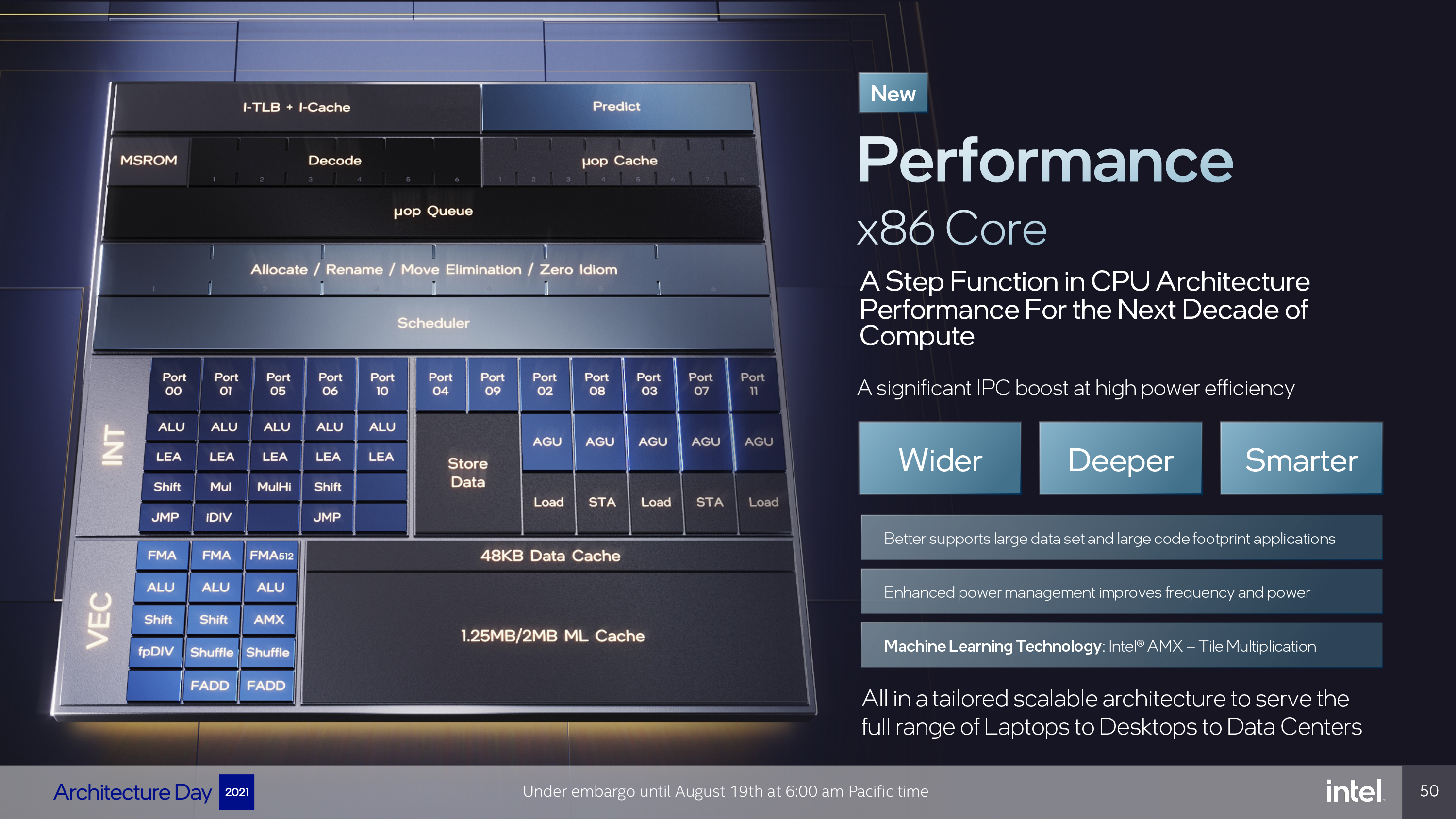


You can read our deep-dive coverage of the Golden Cove Performance Core architecture here. In summary, the Golden Cove microarchitecture is designed for low-latency single-threaded performance and comes with an average of 19% more IPC than the Cypress Cove architecture in Rocket Lake. It also supports AVX-512 and AMX (a new AI-focused matrix-multiply ISA) for data center variants (both are disabled on consumer chips).


You can also read our deep dive coverage of the Gracemont Efficiency Core architecture here. In summary, the single-threaded Efficiency (E) core, which comes with the Gracemont microarchitecture, is designed to improve multi-threaded performance and provide exceptional area efficiency (small footprint) and performance-per-watt. Four of these small cores fit in the same area as a Skylake core and deliver 80% more performance in threaded work (at the same power). A single E core also delivers 40% more performance than a single-threaded Skylake core (at the same power) in single-threaded work (caveats apply to both).



Lakefield served as a proving ground not only for Intel's 3D Foveros packaging tech but also for the software and operating system ecosystem. At its Architecture Day 2020, Intel outlined the performance gains above for the Lakefield chips to highlight the promise of hybrid designs. Still, the results come with an important caveat: These types of performance improvements are only available through both hardware and operating system optimizations. Let's look at Intel's solution to that problem.
Intel Thread Director
Intel unveiled the answer to the software challenge at its Architecture Day 2021 — the new Thread Director. Due to Alder's use of both faster and slower cores that are optimized for different voltage/frequency profiles, unlocking the maximum performance and efficiency requires the operating system and applications to have an awareness of the chip topology to ensure workloads (threads) land in the correct core based on the type of application.
The current thread scheduling systems are based entirely on static rules (priority, foreground, background) and tend to be inefficient and create software programming overhead. That's where Intel's Thread Director technology comes in. This hardware-based technology provides enhanced telemetry data to Windows 11 to assure that threads are scheduled to either the P or E cores in an optimized and intelligent manner, but in a way that's transparent to software.
This technology works by feeding the Windows 11 operating system with low-level telemetry data collected from within the processor itself, thus informing the scheduler about the state of the core, be it power, thermal or otherwise. (As we covered here, Intel has integrated a new power microcontroller in each Gracemont core, a first, that collects similar data on the order of microseconds instead of milliseconds, so it might be part of the new telemetry system.)
Additionally, Thread Director can also detect the instruction mix (scalar/vector) used in any given thread at a nanosecond granularity, and then communicate with the Windows 11 scheduler to steer the thread to the correct execution core, be that a high-performance P-Core or an efficient E-Core. Typically, vector/AI workloads will be prioritized to performance cores while scalar instructions and background tasks are moved to efficiency cores. However, the system is dynamic, so thread placement decisions can vary based on the dynamic mix of conditions and workloads present on the processor at any given time.
Additionally, threads can go through various phases and instruction mixes over their lifetime, so the scheduler constantly re-adjusts based on the real-time telemetry data. This is helpful when the number of threads designated for 'performance' outnumber the available cores, for instance. In that case, less demanding 'performance' threads, such as a program in a spin loop, can be moved off to the efficiency cores while more deserving workloads are assigned to the performance core.
Previously, the operating system didn't have access to this type of telemetry data to inform scheduling decisions, instead using simple data like whether the process was a foreground or background task. This enhanced system allows the operating system and processor to work in tandem to assure correct scheduling in real-time, thus avoiding costly software re-coding. This is a promising sign that existing code will run well on the Alder Lake processors.
Programmers can access more granular control, too, by specifying that certain threads are used in a certain manner through an expansion of the PowerThrottling API that allows developers to assign a QoS attribute to their threads. Additionally, a new EcoQos classification lets software tag threads that respond best on the efficiency cores to assure they are prioritized to execute on the E-Cores. Microsoft says that the Edge browser and 'various' Windows 11 components now take advantage of the EcoQos classification system, and we can expect support to broaden quickly.
This looks to be a promising and less-intrusive (at least from a coding standpoint) method of ensuring that the correct threads land on the correct cores, thus delivering optimal performance. That said, we'll have to see it in action before we can pass judgement on its efficacy – much of its potency will boil down to the latency involved with the process of communicating telemetry data and moving the thread, and intel isn't sharing those details yet. Additionally, it's possible that an excess of communication between the Thread Director and the Windows 11 scheduler could create a challenging workload of its own, so finding the right amount of granularity will be key to assuring both timely thread placement and a minimum of system overhead.
The system is already far in development, and Microsoft says that further enhancements to the engine are already underway and in planning for Windows 11, with more details to be shared at a later date.
Alder Lake chips will also work fine with a bog-standard Windows 10 operating system – existing thread-scheduling techniques continue to work with the processors, just not as well. While the chips work, you'll miss out on the enhanced capabilities of Thread Director (that's Windows 11 only), which will have a varying impact on performance and power consumption based on instruction type and application usage models. In other words, your mileage will vary.
The hybrid architecture could still result in some teething pains, as Intel itself recently divulged that some older games with DRM might not work with the new chips unless developers add specific software optimizations.
Finally, it has long been known that the Gracemont cores do not support the AVX-512 instruction set, and speculation has been rife about how the code would work on Alder Lake processors, if at all. Intel's answer is simple: AVX-512 will not work on either type of core present in Alder Lake. The high-performance cores do feature the Golden Cove architecture that supports AVX-512 natively, but Intel has fused that feature off (yes, the 512-bit FMA is still present and consumes die area) for the consumer chips. In contrast, server chips with Golden Cove have two 512-bit FMAs and fully support AVX-512. Meanwhile, the Gracemont cores are simply not AVX-512 capable, and disabling support allows the Alder Lake chip to have uniform ISA support.
It is completely clear that the AMD vs Intel battle has been reignited. Head to our Intel Core i9-12900K and Core i5-12600K review for additional in-depth testing and buying advice.
- MORE: AMD vs Intel
- MORE: Zen 4 Ryzen 7000 All We Know
- MORE: How to Overclock a CPU
- MORE: How to check CPU Temperature

Paul Alcorn is the Editor-in-Chief for Tom's Hardware US. He also writes news and reviews on CPUs, storage, and enterprise hardware.
-
JayNor An article from tomshardware last year, "DDR5 Specification Released: Fast RAM With Built-In Voltage Regulators", states that a DDR5 LRDIMM supports up to 4TB memory, provided by stacked chips up to 16 levels.Reply
I wonder if Alder Lake will support this amount. -
mspencerl87 I can't say I'm too fond of the BigLittle approach on Desktop CPUs..Reply
Perhaps on Mobile, but I just don't get the benefit on desktop.
Maybe others feel differently. -
TerryLaze Reply
Everybody thought that intel introducing BGA on desktop would mean that it would end up meaning all CPUs but it's only a small percentage for whatever niche intel thought that it would make sense for.mspencerl87 said:I can't say I'm too fond of the BigLittle approach on Desktop CPUs..
Perhaps on Mobile, but I just don't get the benefit on desktop.
Maybe others feel differently.
My guess is that this big.bigger is going to be the same thing, it's going to be in a few things where it makes some sense and everything else will be normal CPUs as we know them. -
JayNor The Gracemont cores are also going in the Grand Ridge chips which will be the successor to the P5900 family base station chips.Reply
Does their use in Alder Lake also suggest some plan by Intel to integrate more networking capabilities into their desktop chips?
For example, accelerated networking might fit into Intel's hybrid cloud plans.
This is an article showing a Grand Ridge slide leak ... 4x 100Gbe.
https://www.overclock3d.net/news/cpu_mainboard/intel_grand_ridge_architecture_leaked_with_ddr5_and_pcie_4_0/1 -
hotaru.hino Reply
While the average home user may not see a point, this can be a pretty big deal for companies that employ thousands of computers in some form or fashion. Like say for example a server that's not really being used because of low demand. Rather than shut it down or put it in deep sleep and hope WoL gets it up, whatever apps and services that makes up the skeleton crew for said server can remain running on the lower power cores until power needs to ramp up again. There's the possibility of both a significant power saving and reducing downtime.mspencerl87 said:I can't say I'm too fond of the BigLittle approach on Desktop CPUs..
Perhaps on Mobile, but I just don't get the benefit on desktop.
Maybe others feel differently.
Though for me, I would really like to reduce my computer's idle/low power usage even further. I'm not hurting on my electric bill, but none the less, chipping off ounces can lead to pounds. -
spongiemaster Reply
Except Intel has already announced it as the architectural sequel to Rocket Lake and Tiger Lake. So unless Intel plans on releasing Alder Lake CPU's without the hybrid configuration, which is one of the major features they are promoting, or there is a surprise unannounced/leaked architecture for high performance desktops, it's not going to be a niche feature.TerryLaze said:Everybody thought that intel introducing BGA on desktop would mean that it would end up meaning all CPUs but it's only a small percentage for whatever niche intel thought that it would make sense for.
My guess is that this big.bigger is going to be the same thing, it's going to be in a few things where it makes some sense and everything else will be normal CPUs as we know them.
CES 2021: Intel Announces Four New Processor Families | Intel Newsroom
"Due in second half of 2021, Alder Lake will combine high-performance cores and high-efficiency cores into a single product. Alder Lake will also be Intel’s first processor built on a new, enhanced version of 10nm SuperFin and will serve as the foundation for leadership desktop and mobile processors that deliver smarter, faster and more efficient real-world computing." -
JWMiddleeton ReplyIntel's recent price adjustments have given Comet Lake a solid value proposition compared to AMD's Ryzen 5000 chips.
I've been rockin' an i7-4790K for over 5 years and the Zen3 processors were a big enticement to finally upgrade. Trouble was I couldn't find one at MSRP, or even close. So, with Comet Lake pricing being reduced, I opted for an i9-10850 on a Z490 MB. I am really happy with the results!
Wonder what will be available in 5 more years? By then I'll be 80 years old and might not care. 🆒
John -
TerryLaze Reply
From this article.spongiemaster said:Except Intel has already announced it as the architectural sequel to Rocket Lake and Tiger Lake. So unless Intel plans on releasing Alder Lake CPU's without the hybrid configuration, which is one of the major features they are promoting, or there is a surprise unannounced/leaked architecture for high performance desktops, it's not going to be a niche feature.
CES 2021: Intel Announces Four New Processor Families | Intel Newsroom
"Due in second half of 2021, Alder Lake will combine high-performance cores and high-efficiency cores into a single product. Alder Lake will also be Intel’s first processor built on a new, enhanced version of 10nm SuperFin and will serve as the foundation for leadership desktop and mobile processors that deliver smarter, faster and more efficient real-world computing."
While this is no confirmation but it only makes sense.
There are also signs that some models will come with only the big cores active, which should perform exceedingly well in gaming.
-
deepfalcon Reply
Its simple. AMDs cores are weaker than Intel thats why they can beat intel in multicore benchmark scores with 2X the core count in a given power budget. While Intel's big cores are substantially better at single core score. With Alderlake, Intel hopes to check mate AMD in both single core score (with Big core) as well as in multicore score with larger total compute power at roughly iso process technology.mspencerl87 said:I can't say I'm too fond of the BigLittle approach on Desktop CPUs..
Perhaps on Mobile, but I just don't get the benefit on desktop.
Maybe others feel differently. -
spongiemaster Reply
Leaks from a while back showed the CPU's with no little cores were clustered at lower core counts. Intel will find a way to leverage those smaller cores for better overall performance, so while you may be able to buy an 8 core AL with no small cores, you're likely not going to want to. It would be like buying a highend CPU today without hyperthreading, except you'll be forgoing even more performance.TerryLaze said:From this article.
While this is no confirmation but it only makes sense.
https://www.tomshardware.com/news/intel-alder-lake-already-looks-confusing-12-configurations-possible





